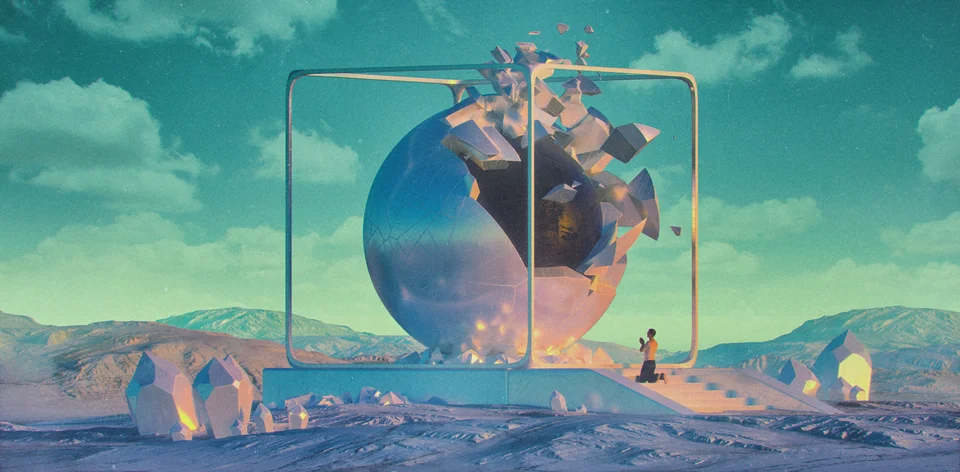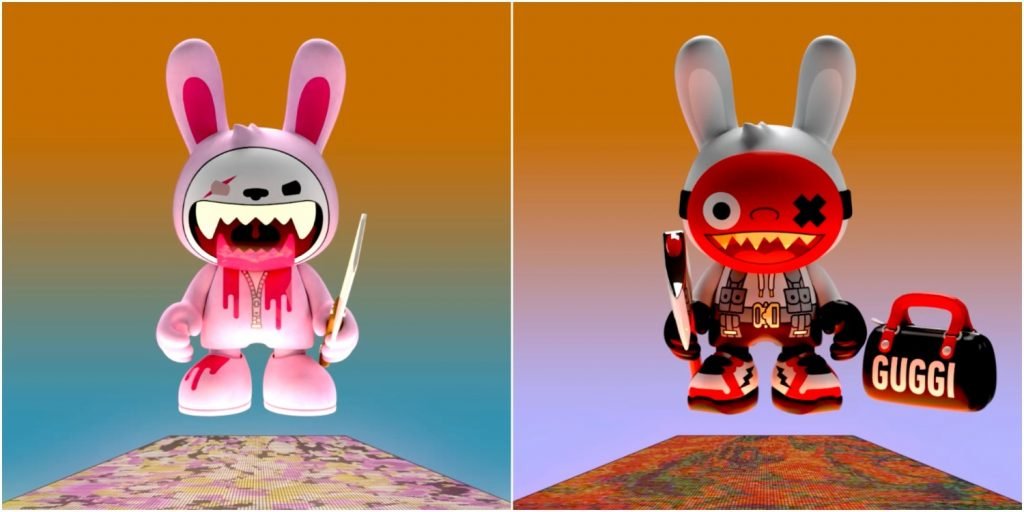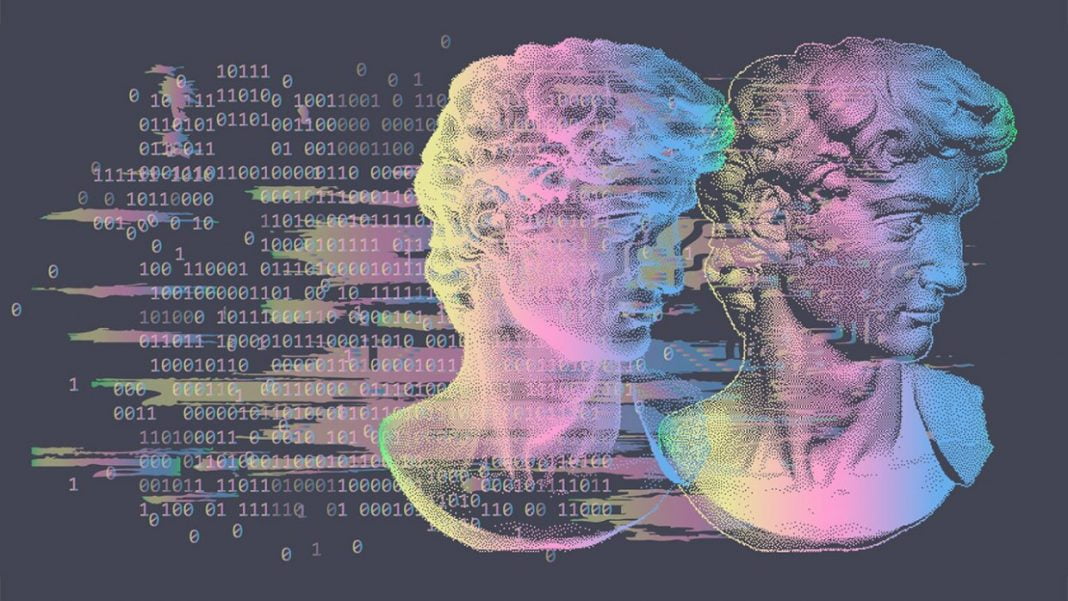If you’re even vaguely familiar with NFTs, you probably know we’re talking about the digital artist Beeple and his artwork “Everydays: The First 5000 Days.” The most expensive digital artwork in history.
One Wild Ride
If this information feels a bit mind-bending to you, you are not alone.
The flourishing market of NFTs is turning art, music, and finance upside down. Recently, Canadian artist and “Martian Technocrat,” Grimes sold almost $6 million dollars of her digital art, and Kings of Leon became the first band to release an album as an NFT. In sports, NBA game highlights can be bought and sold as NFTs like they’re rare trading cards. Although you can watch them online for free.
Only when you thought that the crypto world couldn’t get more bananas, the NFTs craze hit the ground running and took the world by storm. NFT art in particular! Thanks to artists like Beeple and Grimes, 509,000 NFT artworks were sold in March 2021 alone, totaling more than $85 million in sales.
If you’re a digital artist looking to find out more about this phenomenon, understand its pros and cons, create your own NFTs and maybe even make a career out of it, this guide is here to help.
NFTs stand for non-fungible tokens and are digital collectibles.
The term ‘fungible’ is used to describe anything that is not unique in itself. A banknote, for example, is fungible. You can exchange one $5 note for another, without any change in value. Non-fungible is the exact opposite. They are unique or rare, and cannot be replaced with similar items. Antiques are non-fungible. The same goes for art pieces such as the Mona Lisa by Leonardo Da Vinci. And so are NFTs. The difference lies in the fact that the latter are digital.
This non-fungible quality is also exactly why the NFT is different than your run-of-the-mill crypto coin, like Bitcoin and Ethereum. An NFT is unique and cannot be exchanged like-for-like.
While it’s very easy to understand why a unique piece of art is valued at millions of dollars (well, easier at least), it’s been difficult for many to wrap their heads around the idea that a piece of digital art that can be saved by anyone on their computers is valued the same. But the deeper concept of NFTs is ownership. In tangible terms, anyone can buy Lizzo’s latest album as a vinyl, but not many can own it.
How Do NFTs Work?
NFTs are digital assets whose ownership is recorded on a blockchain. Now, what is blockchain? Another great question.
A blockchain is a digital ledger similar to the networks that underpin other cryptocurrencies like Bitcoin or Dogecoin. So imagine a book of accounts that lives online, keeping a public record of who owns what.
More specifically, NFTs are connected to the Ethereum blockchain – probably the most famous blockchain today. So if you buy an NFT, the unique bit of information about the artwork, including contracts, is stored on the blockchain technically forever. Or until the servers go down. But which will likely never happen. Otherwise, Beeple’s NFT will link to the most expensive 404 page in existence.
What Are the Different Types of NFTs?
The better question is what cannot be tokenized? NFTs can be just about anything. JPGs, PNGs, GIFs, MP3s, you name it.
But various media types, being lower-hanging fruit, have been used more often than others. Here a some of the most popular NFTs:
– Digital Art. Mostly sold on SuperRare, KnownOrigin, Async Art, Rarible
– Digital Music. With its own playgrounds like Mintbase, InfiNFT
– Virtual real estate. That’s right. The mogul inside of you can come out on Cryptovoxels, Decentraland
– Gaming assets. Like virtual currency, weapons and avatars. You can find these on Axie Infinity, Sorare, Gods Unchained
– Blockchain domain names. You can find these on Ethereum Name Service, Unstoppable Domains
– Video footage of iconic sports moments
– Tokenized real-world assets, from real estate (the “real” one this time), to cars, racehorses, designer sneakers, and wines, etc.
What Are Famous Examples of NFTs
Between music, art, sports, real estate, pretty much everyone and everything is part of the token game.
Twitter founder and CEO, Jack Dorsey sold his first tweet for $2.9 million USD.
Nyan Cat creator, Chris Torres celebrated the iconic meme’s 10th anniversary with his own NFT auction. Which brought in 300 ETH (Ethereum’s cryptocurrency), worth around $560,000.
Paris Hilton is letting her crypto flag fly by introducing an NFT collection that sold for over $1.1 million. She even created an NFT-focused Instagram account and added laser eyes to her Twitter avatar – the bitcoin bulls’ symbol of solidarity.
Even the famous robot Sophia sold her first NFT collection. And New York Times sold their first-ever column. The list goes on and on.

Almost a Decade in the Making
NFTs may sound like a new concept. The reality?
The concept of NFTs was played around it as early as 2012 when the concept of Bitcoin Colored Coins was born. These fun little coins were just satoshis, which are the smallest units of a Bitcoin. Equivalent to 100 millionth of a coin, they are named after Satoshi Nakamoto, the presumed pseudonymous person who developed bitcoin. For the most part, colored coins were used to create and trade meme artwork.
Yet the first-ever NFT is considered to be Quantum, created in 2014 by Kevin McCoy. Quantum was put together when its creator, alongside Anil Dash, built the first blockchain-backed system for NFTs. At the peak of Tumblr culture where millions of artists were freely sharing artworks with no attribution or compensation, the duo decided to create a platform where digital ownership can exist. Funnily enough, Neither Dash nor McCoy owns the idea of blockchain as they never patented it.

The industry’s first major breakthrough though, came in 2017 when CryptoKitties happened. It was an Ethereum-based NFT game that allowed users to breed rare digital cats on the blockchain. Because cats and the internet go hand in hand, the game became popular and NFTs had a solid claim to fame.
nd while many do not know exactly why 2020 saw the boom of non-fungible tokens, some believe COVID19 has a little something to do with it. That’s right. The “virus whose name shall not be told” called for everything to go digital while forcing everyone to stay indoors. So many artists looked at digital art as a way to express their creativity, and at bitcoin as a way to monetize it.
The Hype With NFT Art
So that’s how NFTs came to rock our world. A bunch of artists on lockdown created and sold their art on the internet. Something to celebrate, for sure.
But the line between art and meme has never been so thin. Established people in the art community do not believe that CrypoKitties or CrypoPunk is art.
Yet some believe the exact opposite. Dylan Field, the 27-year-old founder and CEO of Figma, professed his love for CryptoPunks in a Clubhouse discussion. CryptoPunks appeared around the same time as CryptoKitties and are also considered some of the earliest NFTs on the Etherium blockchain.
They are a collection of 10,000 pixelated portraits of zombies, apes, or aliens, and although they were distributed for free in 2017, Field bought his (the “7804”) in 2018 for $15,000. And sold it in 2021 for $7.5 million to a buyer named Peruggia. We have to stop to appreciate the poetry here, as Peruggia is a nod to the Italian thief who stole the Mona Lisa in 1911 and thus made the piece so famous today. A movie about NFTs is basically writing itself.
Field himself stated: “I personally believe that in 100 years we’ll look back on 7804 as the Mona Lisa of digital art.”

But there is definitely serious critique of the NFT ecosystem because of the inflated and artificial value that it creates.
To bring this to the limelight, designers Vince McKelvie and Sam Newell created a Beeple generator that allows you to make Beeple-style digital art of your own in seconds. By clicking “new Beeple” the site will auto-generate some dystopian landscape with political figures and pop culture references, Beeple-style.
What Are the Downsides of NFTs?
On this note, we can continue to elaborate on why NFTs are so controversial.
While there’s a lot of money to be made, once you peel back the initial layer of NFTs, there are a number of cons that arise.
First off, NFTs use a monster amount of energy in their creation. The site cryptoart.wtf was created to show the exact amount of energy NFTs can consume. But has been taken down since March 2021. Conspiracy, much? In any case, it estimated that some artworks use as much as 192 kWh to make, which is the equivalent of a person’s entire energy consumption for two weeks.
While artists like Beeple have promised to not only release art that is carbon neutral, but carbon negative (whatever that means), we’re not sure that will be possible simply because of the way cryptocurrency systems are built. The process of adding the tokens to the blockchains, combined with the trading transactions result in a major use of energy. Ethereum alone uses the same amount of energy as the entire country of Libya.
Not to mention there are so many unanswered questions about what exactly are you buying into, what can you do with this item, what does it mean when the NFT source does not exist in 20 years, the copyright issues when someone is minting another artist’s work.
There is a huge possibility that emerging artists can be exploited through the NFT market without proper regulators or investigation into whether the person who is minting NFTs has the right to do so. The anonymity of crypto how comes to bite us in the behind.
In the highly volatile and mercurial world of NFTs, the rule book has not entirely been written yet. So you should enter into it knowingly.
On the Flip Side
But there are some upsides we cannot ignore.The wave of NFTs is also set to trigger a wave of artistic innovation and allows creatives to make a career out of their art. NFTs have massively democratized the art space.
Also, because NFTs convert physical assets into digital ones, the market’s efficiency increases drastically. Artists can connect directly with their audiences instead of relying on agents and intermediaries. Not to mention that NFT’s underlying technology is heralded as a decentralized force.

Plus, one other benefit of selling digital art through blockchain is the fact that resale royalties trickle back to the artist. Especially if you’re living in the US. Current US law does not allow artists to receive a percentage of the resale profits made by collectors on the secondary market. Blockchain technology changed that through “smart contracts.” Smart contracts are essentially a piece of self-executing code that allows for the distribution of funds to a named individual upon each transaction.
How to Create NFTs
Choose the best platform for you
With over 50 platforms you can choose from, it’s no wonder that you can get lost. Not all platforms are created equal, so it’s best if you check them out individually.
Some platforms are invite-only, like Nifty Gateway, Knoworigin, and SuperRare. While some require user verification (Rarible, Foundation).
Most platforms also charge a service fee, called a “gas fee” for the computational mining caused by transactions using Ethereum’s blockchain. For example, Nifty Gateway takes 5% plus $0.30 of every secondary sale. SuperRare takes 3% transaction from all purchases, paid by the buyer. Foundation charges up to a whopping 15% commission depending how quickly you want the transaction to be completed and how busy the network is at the time of your transaction. While OpenSea, on the other hand, offers a “lazy minting” option, which amounts to the deferred payment of gas fees until the actual sale.
Yet these gas fees can fluctuate even during the course of one day, so the best thing to do is check the platforms individually when deciding to mint.

In a nutshell
1. Foundation
Also known as Foundation.app, it’s one of the biggest marketplaces for NFTs. Get ready for some live bidding action on this platform. It’s easy to navigate for artists, and for anyone to participate in decentralized bidding for digital creations.
2. Opensea
OpenSea is the largest NFT marketplace around. Anyone can participate, and anything goes here.
3. SuperRare
SuperRare refers to itself as “Instagram meets Christie’s.” Christie’s being the super established 250-years-old auction house that sold Beeple’s masterpieces. Unlike OpenSea, their collection is only NFT crypto art. They only work with a small number of NFT artists that are hand-picked by their profiling process.
Nifty Gateway sells some of the most coveted digital art today. They are constantly selling out of exclusive collections.
5. Rarible
Rarible is another marketplace for trading digital art. One unique thing about this platform is that users can earn themselves RARI tokens, which are referred to as “governance tokens”. These tokens give its user community various rights in the decision-making process of how the platform is run.
How to Sell NFTs
Ether is the most common cryptocurrency you can sell your NFTs for. So it’s easier if you create your NFT on the Ethereum network since this is what most people are using.
The platforms mentioned above all operate the same, so you will most likely have to perform the below steps when setting up your NFT for sale.
First step: create an account. Then create a MetaMask Wallet where your digital currencies will live. MetaMask supports ERC-721 (the Ethereum-based NFT token standard). But you are free to create any other Ethereum wallet, depending on your preference.
After, you can set up single or multiple collectibles, and basically, you can upload anything you want. Depending on the platform, you will be shown the percentage of commissioned gas, or you will be directed to a gasless mint. To save yourself time, make sure you connect your Wallet in this step as well.
Fill out any details they prompt you to, add your file, add any preview images, throw in a description and a name and select whether you want the item’s copyright to transfer over once the sale is made. You can set up a fixed price, or an auction, or a combo of both.
And that’s it! Now you can start selling your new NFT.

Who Owns What
After you’ve sold your piece, unless you gave away your copyright to the buyer, this is how the ownership is distributed:
- The artist is the originator of the artwork and owns the copyright (provided that they actually made the work).
- The buyer receives a certificate of ownership, showcasing every previous owner.
Ready to Create Your NFT?
While the world of NFTs seems hard to navigate, you can only learn by doing. You can’t get rich unless you really, really try. Or however 50 Cents put it.
If you’re a digital artist, this might be a new way for you to make a career out of your passion. Especially if you’re into designing post-apocalyptic, bizzaro landscapes. But also if not! You do not have to fall into the same category as most other digital artists in the NFT space. But again, be mindful of all the downsides of this market from its ecological footprint, the bigger question of that digital ownership actually means, and the big chance that you – as an emerging artist – can easily be taken advantage of.


